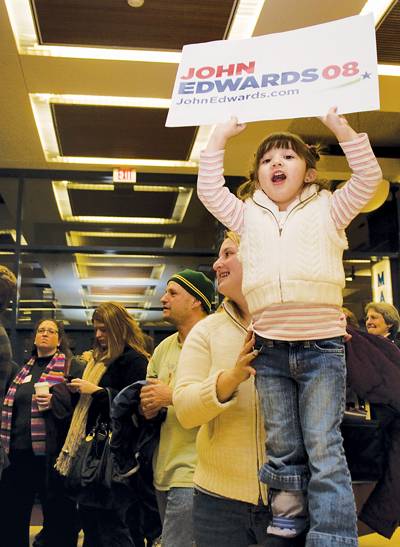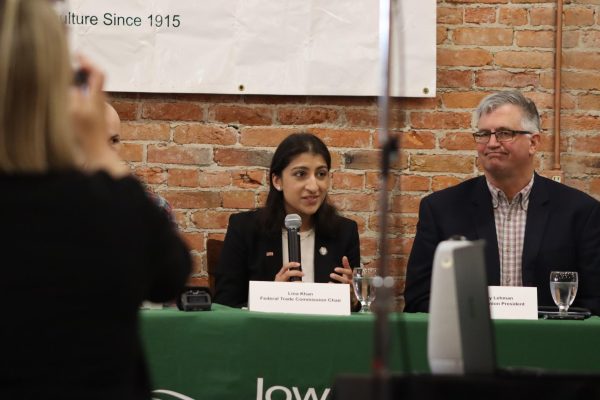Iowa Caucus: Legacy of leadership
November 2, 2015
Iowans are leaders in many areas, most notably agriculture. However, they’re also known for their prowess in picking out world leaders during the Iowa Caucus.
The caucus became the national spectacle it is today in 1976, when the little-known Jimmy Carter surprised everyone by winning it.
“The thing that really put the Iowa Caucuses on the map was almost accidental,” said Mack Shelley, professor of political science.
Carter actually finished second behind uncommitted votes, but it was enough to put his name in the forefront of the 1976 presidential campaign. Carter went on to win the White House that November.
“That made everybody in the media and within both parties start to pay more attention to the Iowa Caucuses,” Shelley said.
The Iowa Caucus used to be a smaller and almost insignificant event with not very many serious conversations, Shelley said.
In the late ’60s and early ’70s, a grassroots movement took place to change and democratize the process of both electing people to go on to the national convention as well as discussing resolutions.
The cause of this was the 1968 Democratic Party National Convention in Chicago, when opposition to the Vietnam War was at its height.
Outside the convention, people were demonstrating for anti-war resolutions to be passed by delegates. The demonstrators were beaten and arrested by Chicago police, causing a large amount of negative media coverage for the Democratic Party.
With the stain of the police riots, the Democrats lost the White House to Richard Nixon in 1968. Those against the war wanted to make sure something similar never happened again, which gave birth to the first modern Democratic caucus in 1972.
Iowa set itself apart from every other state in 1972 by being the first state to caucus at the start of the year.
By 1976, both parties in Iowa were hosting larger caucuses, with more people participating and more issues being discussed.
Because each party is responsible for organizing and running its own caucus, each party has a different process.
Democratic voters have a much more public process.
Attendees of the Iowa Democratic Caucus align themselves with their preferred candidate and form preference groups.
During the forming of presidential preference groups, attendees can choose to declare themselves as uncommitted.
After the first round of groups have been formed, the supporters in the groups with the least support realign with a more supported candidate.
“The realignment process allows attendees to join another group, or acquire more people into a group in order to become more ‘viable,’” said Josh Levitt, the Iowa Democratic Party’s press secretary.
Once all of the preference groups are considered to be viable, county delegates are elected by each group’s members. The winner of the caucus is the candidate who receives the most delegates elected to the county.
After the completion of the presidential preference, Democratic caucusgoers elect Democratic Party precinct leaders. These precinct leaders are responsible for leading party-building efforts.
“The Iowa caucuses on the Democratic side are important not just for presidential preference, but for party building, identifying local leaders and ensuring that people have the opportunity to have their voice heard,” Levitt said.
Shelley said this is one reason the parties prefer the caucus process over a primary.
The Republican process gives caucusgoers more privacy when it comes to choosing a candidate.
Brett Barker, Story County GOP chairman, said the Republican caucus is similar to a straw poll. Each voter casts an anonymous ballot with the name of a single candidate.
Caucusgoers then repeat the process when electing representatives to the county convention, who elect Story County Republican Central Committee members.
The Story County GOP organizes the Iowa Youth Caucus each year to encourage voters to take part in the official Iowa Caucus.
“The state party is also very engaged with ensuring voter turnout,” Barker said.
While both parties’ caucus process is different, the basics of both parties’ caucuses are the same.
Any person who is eligible to vote by Election Day, Nov. 6, 2016, can participate in the 2016 caucus.
Participants must be a registered party member of the party’s caucus, but caucusgoers are able to register at the door.
The Iowa Caucus takes place in thousands of precincts throughout Iowa on caucus night, usually in public buildings and sometimes homes.
However, the Iowa Caucus is not favored by all.
The Iowa Caucus has received a large amount of criticism. Many critics say Iowa is too small, too white, too rural and too conservative to be representative of the nation.
Critics have suggested larger states should be the first to go instead of the lower populated Iowa and New Hampshire.
“Iowa just doesn’t have the political clout it once did,” Shelley said. “And we’re in part living off the fumes from 1976.”
Iowa’s choice of the caucus process as opposed to a primary process has also been criticized.
For a primary, voters may have to wait in line, but they just have to cast a vote on a ballot and they’re done.
The Iowa Caucus lasts for about two to three hours on a weeknight and is in the middle of winter. Attendees must arrive on time to avoid being locked out, and things such as sickness, work and night classes can all affect attendance.
Shelly said the highest Iowa Caucus turnout for Republicans was about 125,000 and Democrats about 250,000, with primaries drawing much higher voter rates.
Shelly said he anticipates high attendance at this year’s Iowa Caucuses since both sides have highly contested candidates.
“You might have as many as 400,000 total,” Shelley said.
In the 2012 Republican caucus, initial results showed former Massachusetts Gov. Mitt Romney with the most votes, but by a small margin. It was later determined that former Pennsylvania Sen. Rick Santorum had won by a slim margin.
This summer, both Iowa parties announced their joint partnership with Microsoft in the development of platform to allow parties to quickly deliver caucus night results.
Both parties will have a mobile app that will directly and securely allow precincts to send in their results to party headquarters. Each party will also have another app allowing their headquarters to monitor and verify incoming numbers.
“Party officials will be able to quickly connect with precinct chairs if issues arise,” Levitt said.
Shelley said the key for a candidate to win the Iowa Caucus is to have a “boots on the ground” kind of presence.
“We tend to like it when people pay attention to us,” Shelley said.
He said with Iowa being ignored the majority of the time, Iowans revel in the national attention the caucus brings.
Shelley said politicians who practice retail politics are favored in the Iowa Caucus. The term retail politics refers to politicians who constantly talk to small numbers of people in a large number of places.
The opposite of retail politics is wholesale, in which politicians try to reach the masses usually through TV ads. Shelley said TV ads tend to turn off Iowa voters.
“You can’t shake hands with a television ad,” Shelley said.

















